Welcome to the STEREO Learning Center
Important STEREO Science Concepts
If you are reading through the STEREO web pages you may come across a number of
terms that are not exactly household words, but are central to a real
understanding STEREO science.
Here are brief discussions of a few of important STEREO Science Concepts:
CORONA
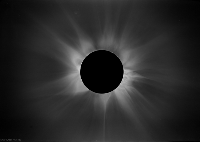 |
The beautiful corona during a 1980 total solar eclipse.
Image courtesy of the High Altitude Observatory and Rhodes College. |
The corona is the Sun's hot, thin outer atmosphere. From Earth it is most easily seen
during a total solar eclipse in which the Sun's bright disk is covered by the Moon, revealing
the much fainter corona.
The highly structured corona is shaped by the Sun's complex magnetic field, and is very
active, exhibiting coronal mass ejections and flares
among other solar magnetic phenomena. The corona is so hot at over a million degrees celcius
that it produces ultraviolet light and X-rays.
STEREO's SECCHI imaging suite shows us the corona in two ways. Its coronagraphs imitate a
solar eclipse in space by covering the disk of the Sun with an occulting disk, so that we can
see scattered light from the corona. The SECCHI Extreme-Ultraviolet Imager (EUVI) lets us
observe the ultraviolet light produced by the corona.
For further reading:
SOLAR WIND
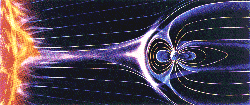 |
Artist's rendition of the relationship between the Sun, the solar wind and Earth's
magnetic field. |
The Sun's super hot atmosphere expands out into the solar system flowing past Earth and the other
planets. In fact, you could say that Earth is inside the outermost layer of the Sun.
This flow is called the Solar Wind and it consists mostly of hydrogen, with some helium and
small amounts of heavier elements. It is exceedingly thin - just a few particles per cubic
centimeter, and moves at velocities from 200 to 800 km/s, or even faster if you count the
fastest CMEs which can move outwards at over 1000 km/s (two million mph).
However, this is still far slower than the speeds of solar energetic
particles which can shoot out at over 100,000 km/s, nearly the speed of light.
The solar wind varies in time and location, with higher speed, lower density streams
flowing out of areas known as coronal holes, where the Sun's magnetic field opens out into
the solar system. The solar wind carries the Sun's magnetic field outwards to form the interplanetary magnetic field (or IMF). The area which is affected by the
solar wind and IMF extends beyond the orbit of Pluto and is know as the heliosphere.
The STEREO PLASTIC and IMPACT instruments sample the solar wind as it passes by the two
spacecraft.
For further reading:
CORONAL MASS EJECTION (CME)
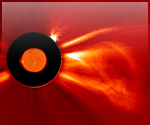 |
An image showing a CME observed by the STEREO's SECCHI/Cor2 coronagraph.
|
A billion tons of matter traveling at a million miles an hour, these giant magnetic
structures blast off the Sun into the solar system and can create major disturbances in
Earth's magnetic field, resulting in the beautiful aurora but also problems with spacecraft
and power systems. They are also a source of Solar Energetic Particles
(SEPs), which are a hazard to astronauts.
Although CMEs are huge and powerful, they are very thin and spread out, with just a few
particles per cubic centimeter. Much of the power they have to affect us comes from their
magnetic fields, which are part of the interplanetary magnetic field, and
can disturb the magnetic field of Earth. It usually takes a CME two to four days to reach
Earth, although extremely fast ones have been known to reach here in just over a day.
Understanding what causes CMEs and how they move through the solar system is one of the
chief goals of the STEREO mission. The CMEs are imaged by the different telescopes in the
SECCHI instrument suite. The actual material in CMEs is measured as they pass the spacecraft
using the IMPACT and PLASTIC instruments, and IMPACT measures their magnetic fields. The
SWAVES instruments observe radio signals produced by shock waves formed as the CMEs plow
through the solar wind.
For further reading:
SOLAR FLARES
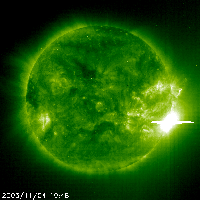 |
One of the brightest solar flares on record on the right (western) limb of the Sun imaged in ultraviolet light by SOHO/EIT. The flare was
so bright the detectors could not handle all the photons, resulting in a series of horizontal
streaks. |
Solar flares are bright, explosive events that take place in the Sun's lower corona. They
can be associated with CMEs, but are not the same thing. Scientists will
use the SECCHI imaging instruments aboard STEREO to improve our understanding of how flares
are related to CMEs.
Although most of what is called a solar flare occurs relatively low in the Sun's
atmosphere, flares do release charged particles which travel along the magnetic field lines of
the interplanetary magnetic field (IMF). Electrons emitted in this way by
flares produce radio waves detected by the SWAVES instruments and allow researchers to map the
IMF.
Sometimes these charged particles may be high enough in energy to qualify as solar energetic particles (SEPs). SEPs along with the X-rays and gamma-rays
produced by flares can be harmful to astronauts.
For further reading:
INTERPLANETARY MAGNETIC FIELD (IMF)
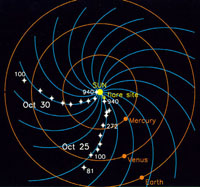 |
A depiction the interplanetary magnetic field. The crosses show the path of energetic particles emitted by flares near the Sun's surface and tracked by the Ulysses spacecraft. |
The Sun's magnetic field is pulled out into space by the charged particles of the Solar Wind. Because the Sun is rotating, structures in the solar wind
tend to form a spiral pattern, like water shooting out of a rotating sprinkler head. As with
the water drops coming out of the rotating sprinkler, the solar wind particles themselves move
straight outwards. However, structures extending across the solar wind flow form a spiral
pattern extending down to the point on the Sun from which they originally came.
Super-fast charged particles called solar energetic particles (SEPs) move
much faster then the solar wind and because they are charged move along rather than across
magnetic field lines. As a result they trace out the spiral pattern of the IMF.
One of the goals of STEREO is to better map the structure of the interplanetary magnetic
field. The STEREO/SWAVES instruments maps that structure using radio signals
given off by energetic charged particles moving along the magnetic field lines. The IMPACT
magnetometers measure the magnetic field at the location of the spacecraft.
For further reading:
SOLAR ENERGETIC PARTICLES (SEPs)
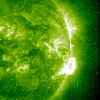
SOHO/EIT |
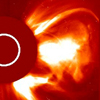 SOHO/LASCO SOHO/LASCO |
A flare and CME that occurred on 21 April 2002 on the western limb of the Sun resulted in SEPs measured at Earth, 90 degrees away in longitude. |
Particles, especially protons, moving at super high speeds can be a deadly hazard to
astronauts and spacecraft. These are frequently emitted during solar activity and are thought
to be caused by CMEs and/or solar flares. Here on
Earth's surface, we are shielded from their damaging effects by Earth's magnetic field.
Most SEPs are protons and electrons, but there are also other heavier particles all of
which are measured by STEREO's IMPACT and PLASTIC instruments. The electrons give off radio
signals which are measured by the SWAVES instruments.
SEPs move at relativistic speeds (30-90% of the speed of light), far faster than the
regular solar wind or coronal mass ejections. Since they are charged particles they move along
the interplanetary magnetic field's spiraling magnetic field lines. Because
of this SEPs are often detected far eastward
of wherethey are thought to originate.
SEPs usually arrive at Earth from 20 minutes to several hours after the start of a flare or
CME. The time it takes for the particles to get here depends on how fast they are going, where
and when the protons are accelerated, and the path they take.
It is still not entirely clear if SEPs are emitted by CMEs as they plow through the solar
wind, by solar flares low in the Sun's atmosphere, or both. The instruments aboard STEREO are
being used to better understand their origins.
For further reading:
SPACE WEATHER
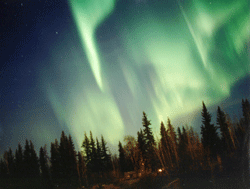 |
The aurora borealis, or northern lights, photographed near Fairbanks, Alaska. These lights in the sky are due to disturbances in the Earth's magnetic field caused by CMEs and other features in the solar wind. Image courtesy of Jan Curtis. |
Space Weather describes changes in the solar system environment caused by variations in the Sun and
Solar Wind. These include, coronal mass ejections and solar
flares, and changes in the interplanetary magnetic field due to solar surface
features like coronal holes. Space weather phenomena cause the beautiful aurora (northern and
southern lights) and can also affect communications, power systems, aviation, and spacecraft. Some
space weather occurrences, such as solar energetic particles can present grave
dangers to astronauts.
Like Earth weather, space weather varies substantially in space and time. A CME headed towards
Earth may completely miss Mars or Venus and vice versa. Spacecraft deployed around the solar system,
like STEREO, will give us a better, solar system wide view of what is happening.
For further reading: